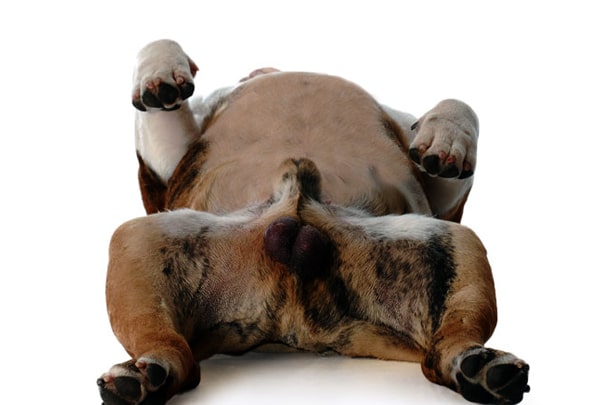Have you ever spayed a female dog or neutered a male dog? The truth is that many people feel uncomfortable when you suggest they should do so. In fact, pets have no concept of gender identity or personal ego. Spaying female dogs and neutering male dogs will not change their instincts or personalities. Pets do not experience any emotional reactions or identity turmoil when they are neutered.

Why Should You Spay Female Dogs and Neuter Male Dogs?
Many people always believe they are being "responsible pet owners" or do not want their dogs to suffer pain. However, a small oversight can lead to unplanned pregnancies. What happens if your dog forgets to close the gate and lets the puppies roam free?
Before you know it, you could accidentally contribute to 5-6 (or more) puppies. Currently, the number of pets has reached an overwhelming level. The only way to truly be a responsible owner is to spay and neuter your pets. Furthermore, spaying female dogs and neutering male dogs can help them avoid certain reproductive health issues.
I Want to Witness the Reproduction of Dogs?
The truth is that dogs usually give birth at night. Their instinct is to hide their puppies, especially in cats. Even if the children want to witness this miracle, you should make them understand that it is not possible.
You should know that the lives of animals depend entirely on human will. If you are a responsible pet owner, the real miracle is that spaying female dogs and neutering male dogs will help limit the number of pets and can save many other animals.
I Want to Maintain Dog Reproduction?
A dog can be a pet with wonderful qualities. But that does not mean that the puppies will be identical replicas of their parents.
For hundreds of years, professional breeders have tracked and observed dog breeds across generations. Despite their extensive experience, no one can guarantee that they will get what they desire from a specific breed. Even if the parent dogs are good specimens, their offspring can still have flaws. Instead of dominant genes, the puppies may carry recessive genes from the parents.
Thus, the chances for amateur pet owners become even slimmer. This is why more and more puppies are abandoned, whether purebred or not. Some people believe they can offset the cost of acquiring pets by breeding them and selling the puppies. However, breeding to standard can actually be more expensive.
Neutering Male Dogs is Against Nature
We intervened in nature when we domesticated dogs. We domesticated dogs about 15,000 years ago and cats about 8,000 years ago. By doing so, we contributed to changing the rules of nature. Every year, humans destroy millions of pets due to overpopulation. This truly goes against the laws of nature.
While they should be in good homes, you might think there is no problem if good homes can be found for the puppies. But each home you find means one less place for abandoned dogs. They also need good shelters. Not to mention that in less than a year, each of your pet's offspring can have their own litters. The numbers will multiply exponentially if we do not spay female dogs and neuter male dogs.
I Only Need to Spay Female Dogs?
This is the most common but also the most ridiculous misconception. Many people still think that it is enough to spay female dogs and that neutering male dogs is unnecessary since only female dogs give birth. However, you forget that a male dog can mate with many female dogs. Anything can happen, even if you think you are never taking your eyes off them.
Similarly, there are many people who only neuter male dogs. This is also a misconception. Female dogs in heat instinctively seek out male dogs. While they are playing outside, there are many risks they could encounter, such as accidents, being stolen, or being trapped.
The Cost of Spaying Female Dogs and Neutering Male Dogs is Too Expensive?
The cost of spaying female dogs and neutering male dogs depends on the animal's gender, size, age, veterinary fees, and several other factors. But no matter what the actual price is, the cost of spaying or neutering is a one-time expense, relatively small compared to all the other benefits.
It's a bargain compared to the medical expenses if your dog becomes pregnant, gives birth, and raises puppies until they can be weaned. Or the costs of treating health issues if your pet encounters reproductive problems. All of these can significantly increase veterinary bills and food expenses if complications arise.
Do Dogs Experience Psychological Changes After Being Spayed or Neutered?
Yes, there will be behavioral changes in pets, but they are positive changes. For example, male cats often reduce marking their territory by urinating. The extent of this behavior reduction depends on the age at which they are neutered. If female dogs and male dogs are spayed or neutered at the right time, before they develop such habits, they may never develop those behaviors.
Spayed dogs tend to fight less. This reduces the risk of contracting infectious diseases and developing abscesses. They also roam outside less because they are no longer interested in searching for females. Therefore, the risk of accidents, getting lost, or being stolen significantly decreases.
Spaying female dogs or neutering male dogs does not affect their instinct to protect the home. A dog's nature is shaped more by genetics and environment than by sex hormones.
Will Spaying Female Dogs Affect Their Health?
Many people believe that pets will become overweight and lazy after being spayed or neutered. The real cause is an unhealthy diet. Dogs are often overfed with inappropriate nutritional components and do not get enough regular exercise. Many owners worry that spaying will lead to a decline in their pets' health, believing it's better to let them have one litter first. However, medical research has proven the opposite.
In fact, female dogs that are spayed before their first heat cycle tend to be healthier. Many veterinarians in advanced countries spay female dogs and neuter male dogs as early as 8 weeks old. Consult with your veterinarian to check and determine the right timing for these procedures. You should also learn about post-operative care for dogs after spaying or neutering to gain necessary experience.
Should You Wait Until Dogs Are 6 Months Old to Spay or Neuter Them?
Many pet owners want to wait until their dogs come into heat before spaying them. The truth is that spaying or neutering dogs or cats after their first heat cycle can increase the risk of certain cancers. Spaying before the heat cycle helps prevent risks associated with hormonal changes or common serious infections in older dogs.
In the past, there was a belief that spaying should not occur until dogs were 6 months old. However, it is now accepted that spaying female dogs and neutering male dogs can start earlier. In the U.S., breeders have been spaying as soon as dogs and cats are 6 to 8 weeks old, and this has not resulted in any adverse effects.
Spaying Dogs Benefits the Community
In the 1950s, people recognized that spaying contributed greatly to community welfare. In New York City, veterinarians from the ASPCA stated that "spaying cats and dogs will prevent and reduce the number of stray cats and dogs." However, there was the issue of a lack of owners willing to care for them.
By 1964, the ASPCA began offering free spaying for pet owners facing financial difficulties. During this time, humane groups across the U.S. started advocating for policies prohibiting the adoption of unspayed cats and dogs.
By 1975, the Maryland SPCA was a pioneer in spaying puppies. This aligned with the previously set policies, requiring adopters to take only spayed cats and dogs, regardless of age.
Spaying Dogs Controls Reproduction
In 1981, Dr. Amy Freeman Lee initiated a similar program in San Antonio, Texas, performing spaying and neutering on many young pets. Veterinarians were not comfortable with this practice. However, many puppies and kittens contributed to uncontrolled reproduction. Once pets experience the urge for mating, they become difficult to manage.
These animals are often abandoned and left without care, facing numerous dangers. If pets are spayed or neutered before they can reproduce, there will be fewer lost puppies and kittens starving to death.
Shelters for cats and dogs across the U.S. began hiring veterinarians to perform spaying and neutering. Veterinarians quickly organized a community. They established a magazine discussing the benefits pet owners would gain from spaying their cats and dogs. This magazine became a significant motivator within the veterinary community. In 1993, the AVMA quickly incorporated pet spaying into their program.
Benefits of Spaying Dogs Before They Reach Maturity
Veterinarians support spaying female dogs and neutering male dogs while they are still young. Some reasons they provide include: The reproductive organs of young pets have fewer blood vessels, leading to minimal blood loss during surgery. They are less likely to become obese, making the surgery easier because veterinarians have to deal with less abdominal fat when suturing.
Additionally, young pets heal quickly. Just five days after surgery, the neuter incision will heal, posing little concern. Early spaying also helps pets avoid complications that can arise when owners take their pets away while they are in heat or pregnant. This also helps prevent complications when your cat or dog accidentally faces illness or injury.
We hope that the information we provide helps you gain a more positive perspective on spaying female dogs and neutering male dogs.








